Article and all photos by Joe Mock, BaseballParks.com
All rights reserved
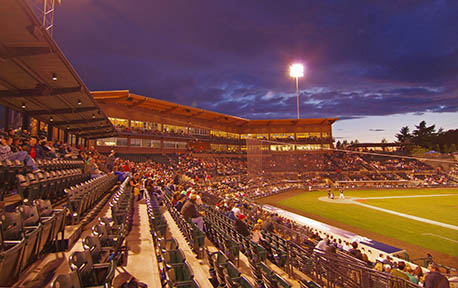 |
In order to put together this review, naturally I traveled to Tacoma’s completely rebuilt Cheney Stadium so I could see it in person. While there, I was chatting with a member of the waitstaff who service the luxury suites. After confirming the direction to look in hopes of seeing Mount Rainier, I saw nothing but clouds. “The next time I attend a game here where I can actually see Mount Rainier will be the first time,” I kiddingly lamented to him. He replied, “The locals here have a saying about that. When the skies are completely clear and you can see Rainier, we say, ‘The mountain is out.’ The rest of the time we say ‘The the mountain’s not out today.'”
| Ballpark Stats |
| Team: Tacoma Rainiers of the Triple-A Pacific Coast League |
| First game after renovation: April 15, 2011, a 6-5 loss to Sacramento |
| Capacity: 7,429. It was 7,200 prior to the renovations |
| Architect for renovations: Populous |
| Construction for renovations: Mortenson |
| Cost of renovation: $30 million |
| Home dugout: 3B side |
| Field points: North by northeast |
| Playing surface: natural grass |
| Betcha didn’t know: a statue of Ben Cheney sits in what was his favorite seat in the ballpark. |
Indeed, I’ve been disappointed that I’ve never been able to see the stunning, majestic peak during any trip I’ve ever made to Tacoma, and this year’s trek was no exception. I’ve heard estimates about how often the “mountain is out” that range from one out of every six days in the summer to about half the time. No matter. I’ve never seen it from Cheney, and that’s a shame because I’d love to shoot some photos with that landmark looming in the background.
Heck, the baseball team is named after that mountain!
Does that mean that attending a game in Tacoma is a washout if the “mountain isn’t out”? Hardly. After all, $30 million was spent rebuilding the stadium following the 2010 season, and the venue has been transformed from one of the weaker parks in Triple-A to a real showplace. In fact, I had Cheney ranked as only the 14th best in the 16-team Pacific Coast League prior to the renovation. Following the face lift, I’ve moved it up six places to number 8 … and it’s very, very unusual for me to change a park’s ranking so significantly.
This tale of how this renovated beauty came to be isn’t nearly as fascinating as the intrigue that surrounded the birth of Werner Park near Omaha, but there are some parallels in the two stories. The original structure was hurriedly built in 1960. That’s because the San Francisco Giants told the city of Tacoma that they would move their top minor league team there from Phoenix if the city could build a park before the start of the 1960 season. The city council quickly approved the project, and $400,000 was spent constructing the ballpark in just over three months. Overseeing the project was local businessman Ben Cheney, who had been a strong advocate for pro baseball during the years leading up to the Giants’ decision to move their team from Arizona to Washington State.
Locals often referred to the ballpark as “The 100-Day Wonder,” in tribute to the brief time period allotted to its construction.
| Not completely demolished |
 |
| In ballpark circles, we often argue over what constitutes a “new” park versus a “renovated” park. While Cheney Stadium was demolished down to its concrete seating bowl (above), its seats and the field itself were pretty much unchanged, making this a “renovation” in my book. PHOTO BY TACOMA RAINIERS |
I’ve seen photos of the stadium the year it opened, and it looked remarkably similar to the structure as recently as 2010 … and therein lies the problem. Ben Cheney’s ballpark was really showing its age in recent years, and its lack of luxury suites, a modern pressbox, a season-ticket-holder club and other amenities was really holding the facility back. This prompted one writer to proclaim, “The uncertainty concerning needed renovations to Cheney Stadium has placed into doubt the future of pro baseball in Tacoma.”
Adding to this speculation was the sale of the team in 2007. The new ownership group, which included entertainer Nick Lachey, was the Schlegel Sports Group out of Dallas, and many feared that out-of-town owners might look for greener pastures — and a new ballpark — for their team.
The new owners entered into discussions with the City of Tacoma on renovations for Cheney. While these conversations were occurring, the owners did look at “potential areas of relocation in the case that the city voted no on the Cheney Stadium project,” noted the Rainiers’ Director of Media Development and Events, Alyson Jones. In the end, though, the Schlegel folks “fell in love with the city of Tacoma,” Jones said, adding that the owners “had no intention or desire to move the Tacoma Rainiers away from Tacoma.”
In November of 2009, the City Council approved a public/private partnership for the stadium renovations, in which the City provided $28 million and an additional two million dollars came from private sources. In exchange, Schlegel agreed to a new lease through 2041. The design-build team of Populous (architects) and Mortenson (construction) was selected as having the best plans, and the day after the regular season ended, demolition began on the structure.
This necessitated that the Rainiers play their post-season games elsewhere. For the first round of the PCL playoffs, their home games were at Safeco Field, just 36 miles north of Cheney on Interstate 5. The finals of the playoffs were played completely on the home field of their opponents, the Memphis Redbirds. Undeterred, the Rainiers prevailed, sweeping their way to the 2010 PCL Championship. All the while, bulldozers and construction workers were hard at work at the team’s home ballpark, ripping off the 51-year-old roof and pressbox, demolishing the bleachers and tearing out everything under the seating bowl.
By the way, a new ownership group took over the club in the spring of 2011, and they are enjoying the fruits of the previous owners’ efforts in the renovated ballpark. The Baseball Club of Tacoma is the group’s name, and it is headed by Mikal Thomsen, a local communications mogul with deep ties to the Puget Sound area.
The Setting
Obviously, the surroundings of the renovated ballpark are no different than prior to the work. Cheney Stadium sits where State Highway 16 makes a bend from west to north, less than two miles west of Exit 132 of Interstate 5.
A word of caution: when you first spot Cheney on your right as you’re traveling west on 16, you’ll be sorely tempted to exit the highway onto a ramp that is right before you. After all, it’s natural to assume that this is the ramp that leads you to the ballpark. Wrong. That ramp whisks you away to the opposite side of the highway, and you will find no signs or hints of how to get over to the ballpark side of 16. How do I know all of this? It’s because I’ve been guilty of this mistake the last two times I visited Cheney. I had to get out my GPS to see what streets to take to get to the stadium. Therefore, make sure you take the 19th Street exit, not the ramp to Center Street.
Cheney’s location is several miles west of downtown Tacoma and its massive docks on the Puget Sound. On one hand, this is a shame, because a view of the Sound would be wonderful. On the other, the site of the ballpark allows fans on the third-base side of the park to see Mount Rainier …. when the “mountain is out,” of course.
This can’t be underemphasized. On those days when the skies are clear and the mountain is visible, it is simply massive, its rounded, snow-covered summit rising thousands of feet above the other peaks near it. I hope one day to see it from within Cheney Stadium! In the meantime, I’ll enjoy the image on the postcard from the 1980s that I uncovered years ago (below left).
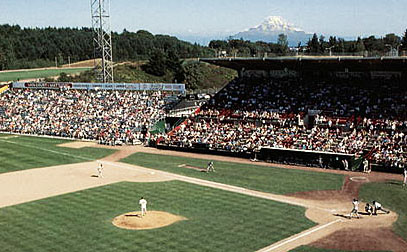  |
Cheney’s neighborhood isn’t one of malls or commercial buildings. To the contrary, the only other structure on this parcel of land between 19th Street and Highway 16 is Henry Foss High School. Baseball fans often park in the school’s lots and walk around to the entryway of Cheney. Elsewhere on the parcel are mature evergreens. The sunset shot (above right) was taken from the walkway behind the suites on the third-base side of the park’s exterior.
The Exterior
And speaking of Cheney’s exterior, the renovation caused it change from moribund to beautiful.
I had a chance to view the renderings of the three “finalists” who were selected to submit their recommended plans for this renovation project. While the other two were certainly attractive, the suggested design from Populous/Mortenson was positively spectacular. Indeed, the finished project is gorgeous. And my hat is off to the City and its various committees who worked on selecting the design and the team to carry out this ambitious project, because the Populous design was by no means the least expensive.
I suspect that the reason it was more expensive was because of the incredible use of natural wood in the exterior and the roof. This gave it a true Northwestern look, just as the much smaller project in Eugene did in 2010 (check out our review of PK Park).
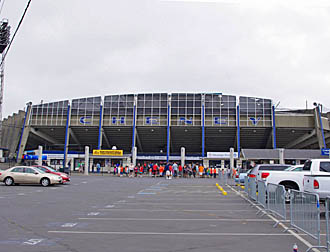 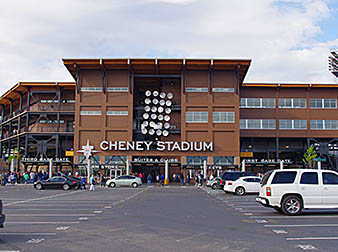 |
Gone is the depressing, dated concrete look of the previous 51 seasons (above left). In its place is a warm, inviting wooden exterior (above right). The structure closest to you in the 2011 shot is actually brand-new. This rectangular building was constructed from scratch on an area that was comprised of an outer concourse and the old entry area.
And while the previous approach funneled most fans through one set of turnstiles directly behind home plate, the renovated Cheney now offers fans four main entryways, including a brand-new one at the rear of the site, behind left field. This is a welcome addition indeed, since quite a few fans park in the high school lots behind the ballpark.
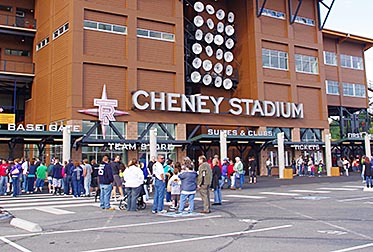 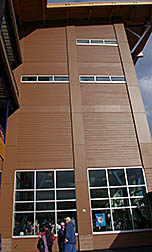 |
As you stand in the parking lot facing the ballpark, you see (from left to right) the Third Base Gate, the entrance to the new souvenir shop, a special gate just for ticket-holders for suites or the Club seats, the box-office windows and the First Base Gate. This arrangement led to an orderly flow of spectators through the gates, even when the gates were first opened to allow fans in.
The shot on the right-hand side above is of the western exterior of the new structure, just outside the store. This shows you just how beautiful the wood really is.
While there are no other entryways behind third base and first base, the new outer wrought-iron fencing is a tremendous upgrade over the old chain-link fence that was there. That, as well as the new construction materials, shows how the exterior behind third base differs from 2010 (left, ugh!) to 2011 (right, ahhh!).
 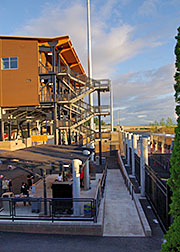 |
So the ballpark’s exterior is now as nice as any in Triple-A, whether the mountain is out or not!
Now let’s see how the $30-million renovation affected the interior of Cheney Stadium.